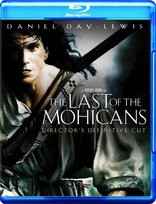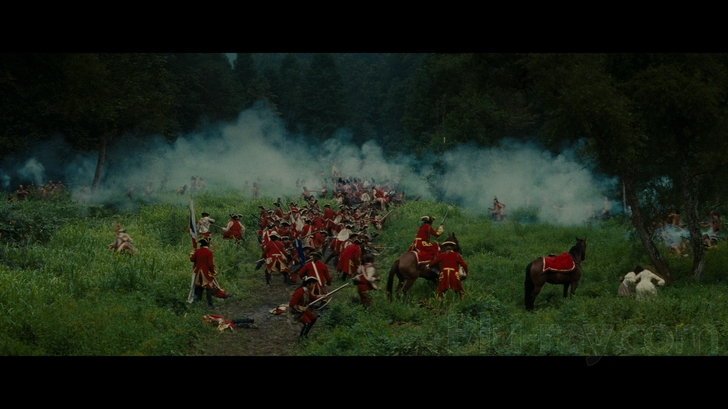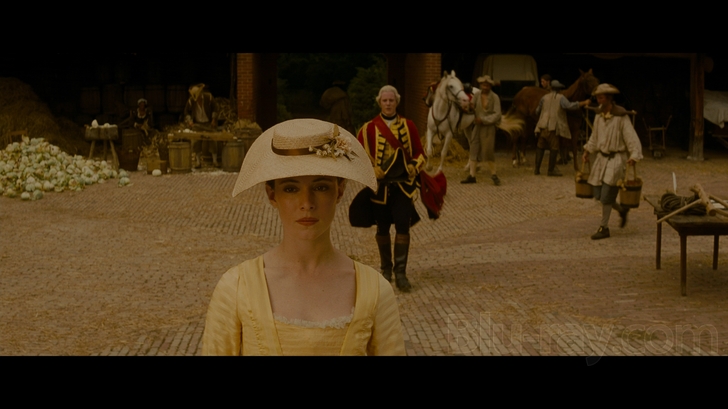The Last of the Mohicans Blu-ray Movie
HomeThe Last of the Mohicans Blu-ray Movie 
Director's Definitive Cut20th Century Fox | 1992 | 115 min | Unrated | Oct 05, 2010

Movie rating
7.9 | / 10 |
Blu-ray rating
| Users | 3.7 | |
| Reviewer | 3.5 | |
| Overall | 3.7 |
Overview
The Last of the Mohicans (1992)
In war-torn Colonial America, in the midst of a bloody battle between British, the French and Native American allies, Cora Munro, the aristocratic daughter of a British Colonel and her party are captured by a group of Huron warriors. Fortunately, a group of three Mohican trappers, including Hawkeye, a rugged frontiersman and the adopted son of the Mohicans comes to their rescue. A passionate romance soon blossoms between Cora and Hawkeye, but many forces test their love as they continue to journey through the Frontier.
Starring: Daniel Day-Lewis, Madeleine Stowe, Russell Means, Eric Schweig, Jodhi MayDirector: Michael Mann
| Epic | Uncertain |
| History | Uncertain |
| War | Uncertain |
| Drama | Uncertain |
| Melodrama | Uncertain |
| Romance | Uncertain |
| Adventure | Uncertain |
Specifications
Video
Video codec: MPEG-4 AVC
Video resolution: 1080p
Aspect ratio: 2.40:1
Original aspect ratio: 2.39:1
Audio
English: DTS-HD Master Audio 5.1 (48kHz, 24-bit)
English: Dolby Digital 2.0 (224 kbps)
Subtitles
English SDH, French, Spanish
Discs
50GB Blu-ray Disc
Single disc (1 BD)
BD-Live
D-Box
Playback
Region A (locked)
Review
Rating summary
| Movie | 4.0 | |
| Video | 3.5 | |
| Audio | 4.0 | |
| Extras | 3.0 | |
| Overall | 3.5 |
The Last of the Mohicans Blu-ray Movie Review
The Last Director’s Cut of the Mohicans?
Reviewed by Casey Broadwater October 5, 2010Michael Mann’s The Last of the Mohicans is the kind of big Hollywood historical romance-action-epic that only comes around once or twice a decade—basically, the sort of film for which the adjective sweeping was invented. Think of it as Danielle Steele-meets-Braveheart- meets-the Tea Party movement, a film that carries us off on a torrid adventure of unbridled female passions, manly valor, and the pursuit of libertarian ideals. But don’t let that description put you off it. (It would definitely send me running if I didn’t know any better.) Mann may slather his film in bigger-than-life emotions—the positively aching score does most of the talking—but he’s adept at turning these feelings into the storybook stuff of American frontier legend. And lest the men-folk grow weary of the mushy stuff, the frequent guns-a’blazin’ and tomahawks-a’hackin’ action scenes—if that’s all you’re after—certainly don’t disappoint. This is a film with something for everyone—chaotic battles, period piece romance, stand-up- to-The-Man political revolt—and while I don’t think The Last of the Mohicans is necessarily groundbreaking cinema, it’s good for satisfying an escapist urge.

The last Mohican is...yes, a white guy. Kind of like Tom Cruise as the last samurai.
We’re escaping, of course, to the wilds of upstate New York in 1757, during the throes of the French and Indian War. (The film is defined by its throes, of passion and violence.) To paint a more complete picture of the political backdrop, the British redcoat overlords are conscripting local militiamen—against their will, leaving their families on the frontier vulnerable to attack—to defend His Majesty’s fortresses from the Gallic forces who want to gain control of the colonies. We’re beginning, here, to see the first stirrings of the American revolutionary spirit; the colonists are peeved, and for good reason—the British Empire seems more concerned with its possessions than its American subjects, who are being slaughtered by native war parties working under the authority of the French.
Under these war-torn circumstances we meet Major Duncan Heyward (Steven Waddington), a redcoat officer in unrequited love with Cora (Madeleine Stowe), the eldest daughter of Colonel Munro (Maurice Roëves), the head honcho at Fort Henry. Duncan is under orders to escort Cora and her sister Alice (Jodhi May) to the fort, but when their native guide Magua (Wes Studi) leads them into an ambush—he’s out to get revenge on Colonel Munro for killing his family—it looks like they’re all about to get scalped, or worse. Rescue comes in the unlikely form of Daniel Day-Lewis, who plays Hawkeye, a white man who was raised from an early age by the dwindling Mohawk tribe, which is now down to exactly three members— himself, his adoptive father Chingachgook (Russell Means), and his brother Uncas (Eric Schweig). They fend off waves of Huron attackers, one tomahawk chop and musket blast at a time, and agree to escort Duncan, Cora, and Alice to the fort, where the film’s core—the love story between Hawkeye and Cora—begins to form in earnest.
You can easily imagine it as the cover of a romance novel—Cora, the prim, proper, virginal Londoner, wrapped in the well-oiled arms of her noble savage lover, whose long brown locks, blowing in the wind, are even more magnificent than hers. This is female fantasy as historical action epic as much as anything, but it makes thematic sense, even if it does get saccharine. Her society is restricted by rules and the complete suppression of desire—Duncan even tells her that friendship and respect alone are enough for a successful marital relationship—while Hawkeye is the embodiment of the natural man, unbound and open, unafraid to say exactly what he feels. Their romance erupts out of nowhere, but this seems appropriate, not rushed—Cora’s feelings mirror the political disgruntledness of the colonists, fed up with the illogical restrictions and unfair policies of British rule. Just as the militiamen are primed for sedition, she’s ready to break free from what’s expected of her—that is, marrying Duncan, a self-serving, cowardly prig—and make her own declaration of independence by falling for the passionate, freedom-loving Hawkeye. A word of warning for those adverse to syrupy Hollywood romance: The Last of the Mohicans gets quite soppy, sometimes literally, as when Hawkeye, standing in a cave with Cora behind a raging waterfall—falling like so many tears—says, “No matter how long it takes, no matter how far, I will find you.”
The film, adapted from James Fennimore Cooper’s dense, bone-dry novel, is surprisingly less about intricate plotting than simple, expressive story beats precision-engineered to generate maximum emotional response from the audience. Mann occasionally lays it on too thick—the score soars and pines, cuing us in to how we’re supposed to feel—but he balances out the chest-heaving theatrics with several brilliantly executed action sequences. War parties swoop down out of the tree-line, confusing the regimented ranks of British soldiers, ramparts and balustrades get blown to smithereens by French cannon fire, and brutal hand-to-hand combat is shown in wide compositions, instead of the hand-held, quick-cut, tightly framed look that would become popular later in the decade. Throughout, Day-Lewis moves like a fleet-footed buck, tearing through the forest with nimble abandon, even loading powder into his rifle on the fly. He’s no usual action hero—all bravado and one-liners—rather, his Hawkeye is confidently stoic, humbly capable. The role may not have the nuance or scenery-chewing intensity of others that he’s played, but Day-Lewis does here was he does best: slip seemingly effortlessly into character. His fellow players do all they can to keep up. Steven Waddington is effectively despicable as Duncan, and Madeleine Stowe powerfully transforms Cora, at first a fragile flower of a woman, into a figure of willful self-determination, even toughness.
The Last of the Mohicans may not seem as grand or moving as it did back in ’92—we’ve had a glut of grand, moving historical epics in the intervening years—but it’s still a thrilling journey through the American frontier, with emotional vistas as opulent as the lush New World scenery. Sweeping, indeed.
The Last of the Mohicans Blu-ray Movie, Video Quality 

Don't be distressed by The Last of the Mohicans' god-awful Blu-ray cover art, which makes Daniel Day Lewis look like a CGI reject from some
late-1990s video game cut-scene. (I know, I know, it's a painting, not a photograph of him, but it still looks terrible.) The film itself looks fairly strong
on
Blu-ray, with a 1080p/AVC-encoded transfer—framed closely to its original 2.39:1 aspect ratio—that sits on a dual-layer disc and runs at an average
bitrate of
38 MBPS. To get the immediate worries out of the way first, the film's inherent grain structure is intact and there's no evidence of any overt digital
tweaking—including DNR, edge enhancement, or drastic color modifications. To put it simply, to my eyes, this is a faithful reproduction. Sharpness is
not
quite as refined as some other big budget catalog titles from the early '90s, but this is still a satisfying high definition presentation that provides
clarified
detail in the actors' faces and a noticeable bump in texture resolution, from the gold epaulets of the British officers' uniforms to the tight weft of Cora's
straw hat. Just don't expect breathtaking clarity.
Color is rich and balanced, as well, especially in the daylight scenes, with lush green grass and foliage, vivid red coats, and warm skintones. Darker
interiors and nighttime forest scenes, however, have a tendency to look murky, with sometimes severely oppressive shadows. The image, overall,
looks somewhat dim. This is at least partially
intentional, but it does put a strain on the eyes. (If your screen is prone to glare, I'd definitely recommend watching at night in a mostly darkened
room.) I didn't spot any compression-related distractions, but during the scene when Hawkeye goes to the Huron camp, there are some mild color
fluctuations, and at 1:35:25, you'll notice a strange, split-second jitter, where Daniel Day Lewis' head remains still, but all of the Native American
actors
behind him shift suddenly in unison. This doesn't look like an encode issue, but rather an example of poor editing, where two takes were spliced
together
awkwardly, resulting in a less-than-fluid jump in movement. (Are there any readers out there who can confirm whether or not this occurs in other
versions of the film?) Aside from this one scene, though, I didn't see anything out of the ordinary. Could the film look better? Probably. Moderately.
Still,
I think most fans will be pleased by The Last of the Mohicans' Blu-ray debut.
The Last of the Mohicans Blu-ray Movie, Audio Quality 

The Last of the Mohicans arrives on Blu-ray with Fox's usual DTS-HD Master Audio 5.1 surround presentation, which reproduces the film's soundtrack with clarity and dynamic expressiveness. When the movie was released theatrically in 1992, many critics praised its bombastic sound design and its sweeping, emotional score by Randy Edelman and Trevor Jones (with additional material by Daniel Lanois and Clannad). While the music seems severely dated now—it can get seriously cloying—there's no denying that it sounds fantastic here, with extremely deep, chest-throbbing cellos, pounding drums, and swelling orchestral arrangements. Likewise, the many battle scenes fill the soundstage with activity; loud gunshots rip and explode directionally, cannons blast with thundering LFE engagement, and horses gallop off through the rears. During less intense scenes, you'll occasionally be immersed in ambience, like crickets, the rush of waterfalls, and the wind in the leaves. However, there is quite a volume disparity between the loud and soft sequences, so you might want to have your remote handy to adjust on the fly if necessary. I found the battle scenes to be a little too boisterous— and slightly brash in the high end—so I'd tamp down the volume, but I'd have to boost it back up whenever characters started talking with their indoor voices again. This, of course, is largely a matter of personal preference. Optional English SDH, Spanish, and French subtitles are available in large, easy- to-read white lettering.
The Last of the Mohicans Blu-ray Movie, Special Features and Extras 

Commentary with Director Michael Mann
Mann delivers a subdued but insightful commentary track that's jam-packed with pertinent information—the historical background of the story, details of
the shooting process, production stories, etc. Things get quiet at times, but overall, this is a worthwhile listen.
Making of The Last of the Mohicans (1080i, 42:42)
For this director's definitive cut, 20th Century Fox has actually put together an extensive production documentary that features on-set footage and new
interviews with Michael Mann, Daniel Day-Lewis, Madeleine Stowe, Native American historian Oren Lyons, and others. Broken into three parts, the
documentary covers nearly every aspect of the production, from Mann's initial interest in the story—he vividly remembers seeing the 1936 film
adaptation—to the casting, the difficulties scouting locations, the film's themes, and Daniel Day-Lewis' intensive training regime. Fans of the film will
most likely want to upgrade from the DVD for this new feature alone.
Theatrical Trailers (SD, 3:18)
Includes the teaser trailer and the original theatrical trailer.
The Last of the Mohicans Blu-ray Movie, Overall Score and Recommendation 

This 114-minute Blu-ray iteration of The Last of the Mohicans is being billed as the "Director's Definitive Cut," but as far as I can tell, it's not too different from the "Expanded Edition" that was released on DVD. I'm sure there are a numerous minor changes that hardcore fans will be able to spot, but there's nothing here that drastically alters the shape or tone of the film. (Although, fans will be glad to hear that the previously excised "Someday, I think you and I are going to have a serious disagreement" quip that Hawkeye delivers to Duncan has been restored. It's the closest Daniel Day-Lewis gets to a one-liner.) The film gets a solid, if not quite perfect Blu-ray presentation, with a faithful A/V presentation, an informative commentary by Mann, and an extensive, all-new making-of documentary that runs just shy of 45 minutes. Recommended!
Other editions
The Last of the Mohicans: Other Editions

The Last of the Mohicans
Director's Definitive Cut
1992

The Last of the Mohicans
Fox Icons
1992

The Last of the Mohicans
Director's Definitive Cut | Awards O-Ring Slipcover
1992

The Last of the Mohicans
Comic Con Exclusive
1992
Similar titles
Similar titles you might also like

Gettysburg
Director's Cut
1993

Australia
2008

Patton
1970

Gone with the Wind
70th Anniversary Edition | Academy Awards O-Sleeve
1939

The Way Back
2010

Gods and Generals
Extended Director's Cut
2003

The Fall of the Roman Empire
1964

Rome: The Complete Series
2005-2006

Rob Roy
1995

Doctor Zhivago
45th Anniversary Edition
1965

The Messenger: The Story of Joan of Arc
1999

War Horse
2011

Spartacus 4K
1960

Flags of Our Fathers
2-Disc Special Edition
2006

Letters from Iwo Jima
2006

Waterloo
1970

The Bridge on the River Kwai
1957

Generation War
Unsere Mütter, unsere Väter
2013

Nomad: The Warrior
2005

The Great Escape 4K
1963